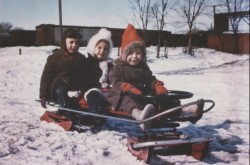Agriculture Museums on the Central Experimental Farm

The Canada Agriculture and Food Museum (CAFM) officially opened on October 12, 1983, 40 years ago this month. The federal agriculture minister at the time, Eugene Whelan, was on hand to help launch it.
He remarked that the Central Experimental Farm (CEF) already showed visitors the present and future of agriculture. With the museum, the site now also demonstrated the past. That day, CAFM opened two exhibitions, Haying in Canada—from Scythe to Forage Harvester and An Ontario Barn in the 1920s. Both used artifacts to show technological change in agriculture.
This was not the first time, however, that an agriculture museum had opened its doors on the Central Experimental Farm. As Whelan then noted, there had once been another museum on the site, which had closed in 1966. In fact, there were two previous incarnations of a CEF museum: one in the Administration Building in the late 1880s, and the second, noted by Whelan, that opened in 1937.
Not much is known of the first museum, however. It was located in the original Administration Building, completed in 1889. The Experimental Farm’s annual report for that year states that “the museum room, which covers the second flat [or floor], is ready to receive the requisite fittings for storing and preserving samples of farm products.”

Administration Building, Central Experimental Farm, ca. 1889. The second floor was used as a museum exhibition space to display agricultural produce.
That description suggests the museum was intended to display produce, like at rural agricultural fairs, where farmers annually showed and judged their harvested crops. Artifact displays of farm machinery were probably not an intended use of this “museum.”
The Administration Building was not universally liked, by some accounts. Cold and draughty, and rather awkward in design, it was demolished in 1939.
By then an agriculture museum had already opened at CEF in 1937 in the Engineering Building (Building 94), which is now the Canada Agriculture and Food Museum’s Learning Centre. The building had just been completed and featured a novel construction method, a steel-truss skeleton that was visible on the second floor. This long, roomy second floor space was used to exhibit artifacts.

The Agriculture Museum in the 1930s. It included exhibits of tools that could then be commonly found on a farm.

A view of the Agriculture Museum, ca. 1930s.
Artifacts were collected from different sources, including from ethnographer Marius Barbeau, who was commissioned in 1936 to find agriculture-related objects in Quebec. This story is told here.
Other artifacts may have been donated to the museum directly from the Central Experimental Farm, a route that has contributed many artifacts to the Ingenium collection over the past five decades. Several of these objects, including those collected by Barbeau, are still in the collection.
The museum closed in 1966 after the Department of Agriculture’s Research Division determined it had neither the resources nor the expertise to run a museum. The Agriculture Museum artifacts were transferred to the National Museum of Man (now known as the Canadian Museum of History). It acted as temporary custodian of the closed museum’s objects until 1967, when it divided the collection and transferred 643 artifacts to the newly established National Museum of Science and Technology.
These objects constituted the core of the agricultural collection that has since grown and is now preserved in the Ingenium Centre, the state-of-the-art collection and administration facility located beside the Canada Science and Technology Museum (CSTM). This collection is the source for artifacts now displayed at CAFM.
Between the closing of the museum in 1966 and the opening of the present-day museum in 1983, agriculture wasn’t completely ignored at the National Museum of Science and Technology. In 1973, a pavilion was built near the present-day CSTM on St. Laurent Boulevard. It housed several exhibitions, including farming equipment that had been restored for the occasion.
The opening of CAFM in 1983 was an important moment. A museum was once again on the site of the Central Experimental Farm, and housed in some of its most historically important buildings. Objects, many of which had been collected starting in 1936, were once again available to be re-exhibited. And all objects now have a secure home in the Ingenium Centre for the benefit of generations to come.
Image gallery
Enjoying the Ingenium Channel? Help us improve your experience with a short survey!





















